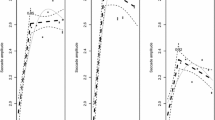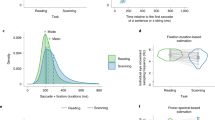Abstract
A growing number of researchers in the sentence processing community are using eye movements to address issues in spoken language comprehension. Experiments using this paradigm have shown that visually presented referential information, including properties of referents relevant to specific actions, influences even the earliest moments of syntactic processing. Methodological concerns about task-specific strategies and the linking hypothesis between eye movements and linguistic processing are identified and discussed. These concerns are addressed in a review of recent studies of spoken word recognition which introduce and evaluate a detailed linking hypothesis between eye movements and lexical access. The results provide evidence about the time course of lexical activation that resolves some important theoretical issues in spoken-word recognition. They also demonstrate that fixations are sensitive to properties of the normal language-processing system that cannot be attributed to task-specific strategies.
Similar content being viewed by others
REFERENCES
Allopenna, P., Magnuson, J. S., & Tanenhaus, M. K. (1998). Tracking the time course of spoken word recognition using eye-movements: evidence for continuous mapping models. Journal of Memory and Language, 38, 419–439.
Altmann, G. T. M. (1998). Ambiguity in sentence processing. Trends in Cognitive Sciences, 2, 146–152.
Altmann, G. T. M., Haywood, S., & Kamide, Y. (2000). Anticipating grammatical function: Evidence from eye movements. Paper presented at the 13th Annual CUNY Conference on Human Sentence Processing, La Jolla, California.
Altmann, G. T. M., & Kamide, Y. (1999). Incremental interpretation at verbs: Restricting the domain of subsequent reference. Cognition, 73, 247–264.
Altmann, G. T. M., & Steedman, M. (1988). Interaction with context during human sentence processing. Cognition, 30, 191–238.
Arnold, J. E., Eisenband, J. G., Brown-Schmidt, S., & Trueswell, J. C. (2000). The rapid use of gender information: Evidence of the time course of pronoun resolution from eyetracking. Cognition, 76, B13–B26.
Chambers, C. G., Tanenhaus, M. K., & Magnuson, J. S. (2000). Does real-world knowledge modulate referential effects on PP-attachment? Evidence from eye movements in spoken language comprehension. Paper presented at the 13th Annual CUNY Conference on Human Sentence Processing, La Jolla, California.
Clark, H. H. (1992). Arenas of language use. Chicago, Illinois: University of Chicago Press.
Cooper, R. M. (1974). The control of eye fixation by the meaning of spoken language. A new methodology for the real-time investigation of speech perception, memory, and language processing. Cognitive Psychology, 6, 84–107.
Crain, S., & Steedman, M. J. (1985). On not being led up the garden path. In D. Dowty, L. Kartunnen & A. Zwicky (Eds.), Natural language parsing (pp. 320–358). Cambridge: Cambridge University Press.
Dahan, D., Magnuson, J. S., & Tanenhaus, M. K. Time course of frequency effects in spokenword recognition: evidence from eye movements, submitted.
Dahan, D., Magnuson, J. S., Tanenhaus, M. K., & Hogan, E. Subcategorical mismatches and the time course of lexical access: Evidence for lexical competition. Language and Cognitive Processes, in press.
Dahan, D., Swingley, D., Tanenhaus, M. K., & Magnuson, J. S. (2000). Linguistic gender and spoken-word recognition in French. Journal of Memory and Language, 42, 465–480.
Eberhard, K. M. (1998). Watching speakers speak: Using eye movements to study language production. Invited paper presented at the 70th Annual Meeting of the Midwestern Psychological Association, Chicago, Illinois.
Eberhard, K. M., Spivey-Knowlton, M., Sedivy, J., & Tanenhaus, M. (1995). Eye movements as a window into real-time spoken language comprehension in natural contexts. Journal of Psycholinguistic Research, 24, 409–436.
Ferreira, F., & Clifton, C. (1986). The independence of syntactic processing. Journal of Memory and Language, 25, 348–368.
Fodor, J. A. (1983). Modularity of mind. Cambridge, Massachusetts: MIT Press.
Francis, W. N., & Kucera, H (1982). Frequency analysis of English usage: Lexicon and grammar. Boston, Massachusetts: Houghton Mifflin Company.
Gaskell, M. G., & Marslen-Wilson, W. D. (1997). Integrating form and meaning: A distributed model of speech perception. Language and Cognitive Processes, 12, 613–656.
Gibson E., & Pearlmutter, N. (1998). Constraints on sentence comprehension. Trends in Cognitive Science, 2, 262–268.
Gilbert, C. D. (1998). Adult cortical dynamics. Physiological Review, 78, 467–485.
Gottlieb, J., Kusunoki, M., & Goldberg, M. E. (1998). The representation of visual salience in monkey posterior parietal cortex. Nature, (London) 391, 481–484.
Griffin, Z. M., & Bock, K. (2000). What the eyes say about speaking. Psychological Science, 11, 274–279.
Hayhoe, M. (2000). Vision using routines: A functional account of vision. Visual Cognition, 7, 43–64.
Hurewitz, F., Brown-Schmidt, S., Gleitman, L., & Trueswell, J. C. (2000). When production precedes comprehension: Children fail to understand constructions that they freely and accurately produce. Paper presented at the 13th Annual CUNY Conference on Human Sentence Processing, La Jolla, California.
Kako. E., & Trueswell, J. C. (2000). Mapping referential competition and the rapid use of verb semantic constraints. Poster presented at the 13th Annual CUNY Conference on Human Sentence Processing, La Jolla, California.
Luce, R. D. (1959). Individual choice behavior. New York: Wiley.
Luce, P. A., & Pisoni, D. B. (1998). Recognizing spoken words: The Neighborhood Activation Model. Ear & Hearing, 19, 1–36.
Magnuson, J. S., Tanenhaus, M. K., Aslin, R. N., & Dahan, D. (1999). Spoken word recognition in the visual world paradigm reflects the structure of the entire lexicon. In M. Hahn & S. Stoness (Eds.), Proceedings of the Twenty First Annual Conference of the Cognitive Science Society, (pp. 331–336). Mahwah, NJ: Erlbaum.
Marslen-Wilson, W. (1987). Functional parallelism in spoken word-recognition. Cognition, 25, 71–102.
Marslen-Wilson, W. (1990). Activation, competition, and frequency in lexical access. In G. T. M. Altmann (Ed.), Cognitive models of speech processing. Psycholinguistic and computational perspectives (pp. 148–172). Hove, UK: Erlbaum.
Marslen-Wilson, W. (1993). Issues of process and representation in lexical access. In G. T. M. Altmann, and R. Shillcock (Eds.), Cognitive models of speech processing: The Second Sperlonga Meeting. (pp. 187–210). Hove, England UK: Lawrence Erlbaum Associates.
Marslen-Wilson, W., & Warren, P. (1994). Levels of perceptual representation and process in lexical access: Words, phonemes, and features. Psychological Review, 101, 653–675.
Matin, E., Shao, K., & Boff, K. (1993). Saccadic overhead: information processing time with and without saccades. Perception & Psychophysics, 53, 372–380.
McClelland, J. L., & Elman, J. L. (1986). The TRACE model of speech perception. Cognitive Psychology, 18, 1–86.
McQueen, J. M., Norris, D., & Cutler, A. (1999). Lexical influence in phonetic decision making: evidence from subcategorical mismatches. Journal of Experimental Psychology: Human Perception and Performance, 25, 1363–1389.
Meyer, A. S., Sleiderink, A. M., & Levelt, W. J. M. (1999). Viewing and naming objects: eye movements during noun phrase production. Cognition, 66, B25–B33.
Nadig, A., & Sedivy, J. C. (2000). Children's use of referential pragmatic constraints in production and processing. Paper presented at the 13th CUNY Conference on Human Sentence Processing, La Jolla, California.
Nicol, J., & Swinney, D. (1989). The role of structure in coreference assignment during sentence comprehension. Journal of Psycholinguistic Research, 18, 5–19.
Norris, D. (1994). Shortlist: a connectionist model of continuous speech recognition. Cognition, 52, 189–234.
Norris, D., McQueen, J. M., & Cutler, A. (2000). Merging information in speech recognition: feedback is never necessary. Behavioral & Brain Sciences, 23, 299–370.
Pollack, I., Rubenstein, H., & Decker, L. (1959). Intelligibility of known and unknown message sets. Journal of Acoustical Society of America, 31, 273–279.
Rayner, K. (1998). Eye movements in reading and information processing: 20 years of research. Psychological Bulletin, 124, 372–422.
Runner, J. T., Sussman, R., & Tanenhaus, M. K. (2000). Binding reflexives and pronouns in real-time processing. Poster presented at the 13th Annual CUNY Conference on Humand Sentence Processing, La Jolla, California.
Sedivy, J. C., Tanenhaus, M. K., Chambers, C. G., & Carlson, G. N. (1999). Achieving incremental semantic interpretation through contextual representation. Cognition, 71, 109–147.
Simons, D. J. (2000). Change blindness and visual memory. Visual Cognition, [S.I] 7, 1–416.
Sommers, M. S., Kirk, K. I., & Pisoni, D. B. (1997). Some consideration in evaluating spoken word recognition by normal-hearing, noise-masked normal hearing, and cochlear implant listeners. I: The effects of response format. Ear and Hearing, 18, 89–99.
Spivey-Knowlton, M. J. (1996). Integration of visual and linguistic information: Human data and model simulations. Ph.D. dissertation, University of Rochester.
Spivey, M. J., & Marian, V. (1999). Cross talk between native and second languages: Partial activation of an irrelevant lexicon. Psychological Science, 10, 281–284.
Spivey, M. J., & Tanenhaus, M. K. (1998). Syntactic ambiguity resolution in discourse: Modeling the effects of referential context and lexical frequency. Journal of Experimental Psychology: Learning, Memory, and Cognition, 24, 1521–1543.
Spivey, M. J., Tanenhaus, M. K., Eberhard, K. E., & Sedivy, J. C. (2000). Eye movements and spoken language comprehension: Effects of visual context on syntactic ambiguity resolution. Cognitive Psychology, in press.
Streeter, L. A., & Nigro, G. N. (1979). The role of medial consonant transitions in word perception. The Journal of Acoustical Society of America, 65, 1533–1541.
Sussman, R., & Sedivy, J. C. (2000). Using eyetracking to detect and describe failed gap effects. Poster presented at the 13th Annual CUNY Conference on Human Sentence Processing, La Jolla, California.
Tanenhaus, M. K., Dahan, D., Magnuson, J. S., & Hogan, E. (2000). Tracking the time course of subcategorical mismatches on lexical access. Paper presented at the 13th Annual CUNY Conference on Human Sentence Processing, La Jolla, California.
Tanenhaus, M. K., & Spivey-Knowlton, M. J. (1996). Eye-tracking. Language and Cognitive Processes, 11, 583–588.
Tanenhaus, M. K., Spivey-Knowlton, M. J., Eberhard, K. M., & Sedivy, J. C. (1995). Integration of visual and linguistic information in spoken language comprehension. Science, 268, 1632–1634.
Tanenhaus, M. K., Spivey-Knowlton, M. J., Eberhard, K. M., & Sedivy, J. C. (1996). Using eye movements to study spoken language comprehension: Evidence for visually mediated incremental interpretation. In T. Inui & J. McClelland (Eds.), Attention & performance XVI: Integration in perception and communication. (pp. 457–478). Cambridge, Massachusetts: MIT Press.
Tanenhaus, M. K., Spivey-Knowlton, M. J., & Hanna, J. E. (2000). Modeling thematic and discourse context effects on syntactic ambiguity resolution within a multiple constraints framework: Implications for the architecture of the language processing system. In M. Pickering, C. Clifton, & M. Crocker (Eds.), Architecture and mechanisms of the language processing system. Cambridge: Cambridge University Press.
Tanenhaus, M. K., & Trueswell, J. (1995). Sentence comprehension. In J. Miller & P. Eimas (Eds.), Speech, language, and communication (pp. 217–595). San Diego, California: Academic Press.
Trueswell, J. C., Sekerina, I., Hill, N., & Logrip, M. (1999). The kindergarten-path effect: Studying on-line sentence processing in young children. Cognition, 73, 89–134.
Whalen, D. H. (1984). Subcategorical phonetic mismatches slow phonetic judgments. Perception & Psychophysics, 35, 49–64.
Whalen, D. H. (1991). Subcategorical phonetic mismatches and lexical access. Perception & Psychophysics, 50, 351–360.
Yee, E., Blumstein, S., & Sedivy, J. C. (2000). The time course of lexical activation in Broca's aphasia: Evidence from eye movements. Poster presented at the 13th Annual CUNY Conference on Human Sentence Processing, La Jolla, California.
Author information
Authors and Affiliations
Rights and permissions
About this article
Cite this article
Tanenhaus, M.K., Magnuson, J.S., Dahan, D. et al. Eye Movements and Lexical Access in Spoken-Language Comprehension: Evaluating a Linking Hypothesis between Fixations and Linguistic Processing. J Psycholinguist Res 29, 557–580 (2000). https://doi.org/10.1023/A:1026464108329
Issue Date:
DOI: https://doi.org/10.1023/A:1026464108329




